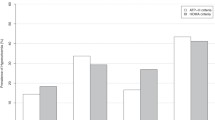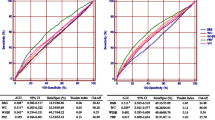Abstract
Objective
To explore the relationships between visceral adiposity index (VAI), hypertriglyceridemic waist phenotype (HW phenotype) and chronic kidney disease (CKD).
Methods
A cross-sectional study was conducted in Zhuhai City June–October 2012. A total of 2142 participants were recruited. Logistic regression was used to evaluate the associations between VAI, HW phenotype and CKD.
Results
After adjustment for age, VAI was significantly associated with CKD (OR 2.16, 95 % CI 1.25–3.74, P = 0.006) in women. Further adjusted for potential confounders, the association was still significant in women (OR 2.07, 95 % CI 1.17–3.64, P = 0.01). However, the association was abolished when adding diabetes and hypertension to the model (OR 1.68, 95 % CI 0.92–3.06, P = 0.09). The age-adjusted OR (95 % CI, P) of CKD associated with HW phenotype was 2.21 (1.29–3.76, 0.004) and 2.54 (1.53–4.22, <0.001) for men and women, respectively. Further adjusted for potential confounders, the associations were still significant in both subgroups. The OR for CKD was 2.41 (95 % CI 1.42–4.12, P = 0.001) and 2.32 (95 % CI 1.31–4.11, P = 0.004) for women and men, respectively. When further adjusted for diabetes and hypertension, the association of HW phenotype and CKD was significant (OR 1.88, 95 % CI 1.05–3.36, P = 0.033) in women. However, the model is abolished in men (OR 1.50, 95 % CI 0.81–2.78, P = 0.19).
Conclusion
Our results suggest that both VAI and the HW phenotype might be useful clinical indicators of CKD in China for females but not for males. The HW phenotype associated more strongly with CKD, compared with VAI.

Similar content being viewed by others
References
Zhang L, Wang F, Wang L, Wang W, Liu B et al (2012) Prevalence of chronic kidney disease in China: a cross-sectional survey. Lancet 379:815–822
Zhang L, Wang H (2009) Chronic kidney disease epidemic: cost and health care implications in China. Semin Nephrol 29:483–486
Wang H, Zhang L, Lv J (2005) Prevention of the progression of chronic kidney disease: practice in China. Kidney Int Suppl 67:S63–S67
Ayodele OE, Alebiosu CO (2010) Burden of chronic kidney disease: an international perspective. Adv Chronic Kidney Dis 17:215–224
Schieppati Arrigo, Remuzzi Giuseppe (2005) Chronic renal diseases as a public health problem: epidemiology, social, and economic implications. Kidney Int 68:S7–S10
Eknoyan G, Lameire N, Barsoum R, Eckardt KU, Levin A et al (2004) The burden of kidney disease: improving global outcomes. Kidney Int 66:1310–1314
Hall JE, Henegar JR, Dwyer TM, Liu J, da Silva AA et al (2004) Is obesity a major cause of chronic kidney disease? Adv Ren Replace Ther 11:41–54
Navaneethan SD, Kirwan JP, Arrigain S, Schreiber MJ, Sehgal AR et al (2012) Overweight, obesity and intentional weight loss in chronic kidney disease: nHANES 1999–2006. Int J Obes (Lond) 36:1585–1590
Pinto-Sietsma S-J, Navis G, Janssen WM, de Zeeuw D, Gans RO et al (2003) A central body fat distribution is related to renal function impairment, even in lean subjects. Am J Kidney Dis 41:733–741
Kim SR, Yoo JH, Song HC, Lee SS, Yoo SJ et al (2011) Relationship of visceral and subcutaneous adiposity with renal function in people with type 2 diabetes mellitus. Nephrol Dial Transplant 26:3550–3555
Lemieux I, Alme´ras N, Mauriege P, Blanchet C, Dewailly E et al (2002) Prevalence of hypertriglyceridemic waist in men who participated in the Quebec Health Survey: association with atherogenic and diabetogenic metabolic risk factors. Can J Cardiol 18:725–732
Ross R, Aru J, Freeman J, Hudson R, Janssen I (2002) Abdominal adiposity and insulin resistance in obese men. Am J Physiol Endocrinol Metab 282:E657–E663
Ross R, Freeman J, Hudson R, Janssen I (2002) Abdominal obesity, muscle composition, and insulin resistance in premenopausal women. J Clin Endocrinol Metab 87:5044–5051
Li Y, Zhou C, Shao X, Liu X, Guo J et al (2014) Waist phenotype and chronic kidney disease in a Chinese population aged 40 years and older. PLoS ONE 9(3):e92322. doi:10.1371/journal.pone.0092322
Li Y, Zhao L, Chen Y, Liu A, Liu X et al (2013) Association between metabolic syndrome and chronic kidney disease in perimenopausal women. Int J Environ Res Public Health 10:3987–3997
Li Y, Zhou C, Shao X, Liu X, Guo J et al (2014) Hypertriglyceridemic waist phenotype and chronic kidney disease in a Chinese population aged 40 years and older. PLoS ONE 9:e92322
Li Y, Chen Y, Liu X, Liang Y, Shao X et al (2014) Metabolic syndrome and chronic kidney disease in a Southern Chinese population. Nephrology (Carlton) 19:325–331
Knapp M, Hadid O (1987) Investigations into negative interference by jaundiced plasma in kinetic Jaffé methods for plasma creatinine determination. Ann Clin Biochem 24:85
Amato MC, Giordano C, Galia M, Criscimanna A, Vitabile S et al (2010) Visceral adiposity index: a reliable indicator of visceral fat function associated with cardiometabolic risk. Diabetes Care 33:920–922
Du T, Sun X, Huo R, Yu X (2013) Visceral adiposity index, hypertriglyceridemic waist and risk of diabetes: the China Health and Nutrition Survey 2009. Int J Obes. doi:10.1038/ijo.2013.181
Ma Y-C, Zuo L, Chen J-H, Luo Q, Yu X-Q et al (2006) Modified glomerular filtration rate estimating equation for Chinese patients with chronic kidney disease. J Am Soc Nephrol 17:2937–2944
Grundy SM, Cleeman JI, Daniels SR, Donato KA, Eckel RH et al (2005) Diagnosis and management of the metabolic syndrome: an American Heart Association/National Heart, Lung, and Blood Institute Scientific Statement. Circulation 112(17):2735–2752
Ng A, Wai D, Tai E, Ng K, Chan L (2012) Visceral adipose tissue, but not waist circumference is a better measure of metabolic risk in Singaporean Chinese and Indian men. Nutr Diabetes 2:e38
Cornier MA, Despres JP, Davis N, Grossniklaus DA, Klein S et al (2011) Assessing adiposity: a scientific statement from the American Heart Association. Circulation 124:1996–2019
Oh J-Y, Sung Y-A, Lee HJ (2013) The visceral adiposity index as a predictor of insulin resistance in young women with polycystic ovary syndrome. Obesity (Silver Spring, Md) 21:1690–1694
Kahn HS, Cheng YJ (2008) Longitudinal changes in BMI and in an index estimating excess lipids among white and black adults in the United States. Int J Obes (Lond) 32:136–143
Lemieux I, Pascot A, Couillard C, Lamarche B, Tchernof A et al (2000) Hypertriglyceridemic waist: a marker of the atherogenic metabolic triad (hyperinsulinemia; hyperapolipoprotein B; small, dense LDL) in men? Circulation 102:179–184
LaMonte MJ, Ainsworth BE, DuBose KD, Grandjean PW, Davis PG et al (2003) The hypertriglyceridemic waist phenotype among women. Atherosclerosis 171:123–130
Arsenault BJ, Lemieux I, Despres J-P, Wareham NJ, Kastelein JJP et al (2010) The hypertriglyceridemic-waist phenotype and the risk of coronary artery disease: results from the EPIC-Norfolk prospective population study. CMAJ 182:1427–1432
Lemieux I, Almeras N, Mauriege P, Blanchet C, Dewailly E et al (2002) Prevalence of ‘hypertriglyceridemic waist’ in men who participated in the Quebec Health Survey: association with atherogenic and diabetogenic metabolic risk factors. Can J Cardiol 18:725–732
Després J-P, Lemieux I, Bergeron J, Pibarot P, Mathieu P et al (2008) Abdominal obesity and the metabolic syndrome: contribution to global cardiometabolic risk. Arterioscler Thromb Vasc Biol 28:1039–1049
Weinberg JM (2006) Lipotoxicity. Kidney Int 70:1560–1566
Kwakernaak AJ, Zelle DM, Bakker SJ, Navis G (2013) Central body fat distribution associates with unfavorable renal hemodynamics independent of body mass index. J Am Soc Nephrol 24:987–994
Roubicek T, Bartlova M, Krajickova J, Haluzikova D, Mraz M et al (2009) Increased production of proinflammatory cytokines in adipose tissue of patients with end-stage renal disease. Nutrition 25(7–8):762–768
Shively CA, Register TC, Clarkson TB (2009) Social stress, visceral obesity, and coronary artery atherosclerosis: product of a primate adaptation. Am J Primatol 71(9):742–751
Acknowledgments
This study was supported by the following Science Foundation: 1. EU FP7 Program, Autosense, 2011; 2. Guangdong Provincial Science and Technique Program (No. 2011B031800386), 2011.
Author information
Authors and Affiliations
Corresponding authors
Ethics declarations
Conflict of interest
The Authors declare that there is no conflict of interest.
Additional information
Jun Huang and Chaomin Zhou have contributed equally to this work.
Rights and permissions
About this article
Cite this article
Huang, J., Zhou, C., Li, Y. et al. Visceral adiposity index, hypertriglyceridemic waist phenotype and chronic kidney disease in a southern Chinese population: a cross-sectional study. Int Urol Nephrol 47, 1387–1396 (2015). https://doi.org/10.1007/s11255-015-1040-y
Received:
Accepted:
Published:
Issue Date:
DOI: https://doi.org/10.1007/s11255-015-1040-y




